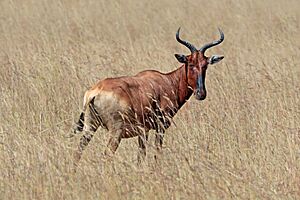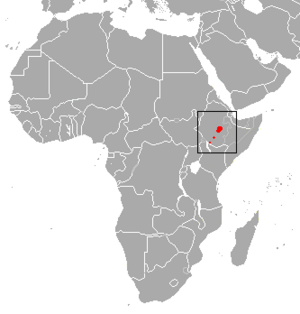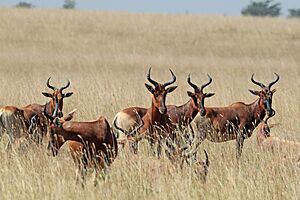Swayne's hartebeest facts for kids
Quick facts for kids Swayne's hartebeest |
|
|---|---|
 |
|
| Senkelle Swayne's Hartebeest Sanctuary, Ethiopia | |
| Conservation status | |
| Scientific classification |
|
| Kingdom: | Animalia |
| Phylum: | Chordata |
| Class: | Mammalia |
| Order: | Artiodactyla |
| Family: | Bovidae |
| Subfamily: | Alcelaphinae |
| Genus: | Alcelaphus |
| Species: | |
| Subspecies: |
A. b. swaynei
|
| Trinomial name | |
| Alcelaphus buselaphus swaynei (Sclater, 1892)
|
|
 |
|
| Range of the Swayne Hartebeest (in red) | |
The Swayne's hartebeest (Alcelaphus buselaphus swaynei) is a type of antelope that lives in Ethiopia. It is an endangered animal, meaning there are not many left in the wild.
You can find the largest groups of Swayne's hartebeest in places like Senkelle Swayne's Hartebeest Sanctuary, Nechisar National Park, and Maze National Park. Sadly, this animal no longer lives in Somalia. It was named after a British officer, H. G. C. Swayne.
Contents
What is a Swayne's Hartebeest?
Swayne's hartebeest is a type of hartebeest. Hartebeests are large antelopes found in Africa. They are known for their long faces and unique horn shapes.
Where Do They Live?
Swayne's hartebeests prefer to live in grassland areas. They like these open, grassy places in both the wet and dry seasons. They especially enjoy areas with short grass, usually less than 30 centimeters tall, for eating.
Why Burned Grasslands Are Important
These hartebeests also like to feed in areas where the grass has recently been burned. This might seem strange, but new, fresh grass often grows quickly after a fire. This preference for burned patches is very important for scientists. It helps them create good plans to protect these animals and their homes.
Population Status
In the past, before the 1890s, Swayne's hartebeest was very common. They lived all over Ethiopia and Somalia.
Why Their Numbers Dropped
Around the mid-1890s, a serious animal sickness spread. This sickness caused many wild animals and farm animals to die. It was a very hard time for the Swayne's hartebeest. Their numbers dropped a lot, and they were in danger of disappearing completely.
Today, they are still an endangered species. This means people are working hard to protect them and help their populations grow again.




